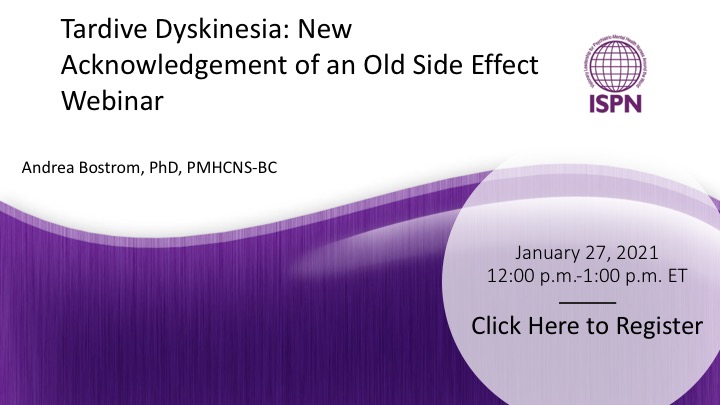Tardive Dyskinesia: New Acknowledgement of an Old Side Effect
Webinar

Presenter: Andrea Bostrom, PhD, PMHCNS-BC
Date: Wednesday, January 27, 2021
Time: 12:00 p.m. - 1:00 p.m. ET
Summary:
Tardive dyskinesia (TD), a movement disorder, is a side effect of antipsychotic medications. The movements of TD include choreiform and athetoid movements of the face, mouth, tongue, fingers, toes, limbs, and trunk. The movements are indistinguishable from Huntington’s disease except for history. The side effect was first described in the 1960s and identified with increasing frequency during the subsequent decades as the use of first-generation antipsychotic medications became the standard of care for psychosis. Of considerable concern was the fact that there was no cure for TD; it appeared that once an individual developed TD, movements were permanent. As the prevalence of TD increased, several practices were questioned, particularly the use of antipsychotic medications for non-psychotic disorders. In the late 1900s, as second-generation antipsychotic medications were developed and used more frequently, the indications were that the incidence of TD was decreasing because these medications were less causative. In addition, nothing had been identified to treat or ameliorate the movements. As a result, less emphasis was placed on the systematic monitoring for this side effect.
In actuality, while the incidence of TD appears to be less with second generation antipsychotic medications, it has not disappeared. In addition, the use of these medications for an increasing number of psychiatric disorders should cause concern if TD can still develop. Finally, the metabolic side effects of the second generation antipsychotic drugs may suggest that the first-generation antipsychotics may still be useful. A new medication, valbenazine, has shown some promise in treating TD and has resulted in an increased interest in identifying this movement disorder side effect. As a result, systematic monitoring for TD is important. The use of reliable and valid assessment tools is essential. This presentation will describe the movements of TD, the causes and risks for development of TD, appropriate assessment and monitoring procedures, and prevention and treatment of TD.
To Receive 1.0 Advanced Pharmacotherapy contact hour:
For this webinar, ISPN has applied for one (1) Advanced Pharmacotherapy contact hour from the Ohio Nurses Association, an accredited approver by the American Nurses Credentialing Center’s Commission on Accreditation (OBN-001-91). After attending the webinar, please complete the evaluation.
Criteria for Successful Completion
To obtain one continuing education contact hour, one must attend the entire webinar and complete the evaluation.
Conflict of Interest
There is no conflict of interest for anyone with the ability to control content for this activity.
Activity Approval Statement
This activity has been submitted to the Ohio Nurses Association for approval to award contact hours. The Ohio Nurses Association is accredited as an approver of nursing continuing professional development by the American Nurses Credentialing Center's Commission on Accreditation. (OBN-001-91).
Activity Number: 2020-0000000937
Cost:
- ISPN Full, Retired, and Student Member: Free
- Non-Member: $25
To receive ISPN member pricing, please login to the members only section of the website.
Steps: First, register through our website here. You will then receive an email with links to register on GoToWebinar. Please make sure to register on GoToWebinar through the link for access to the webinar.
|